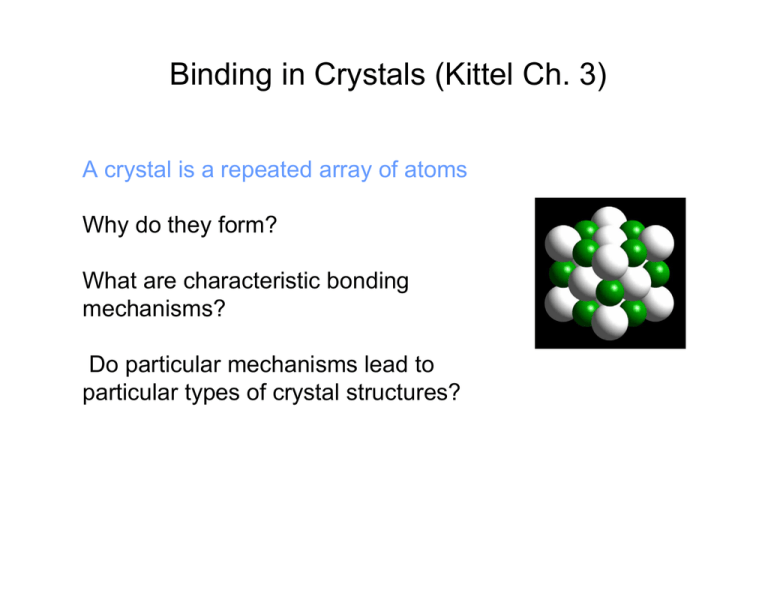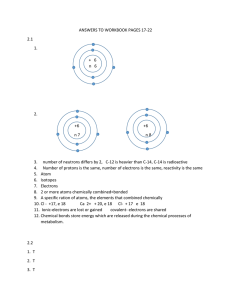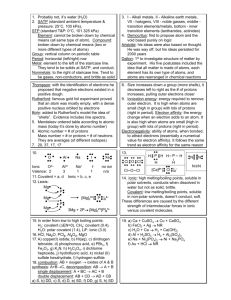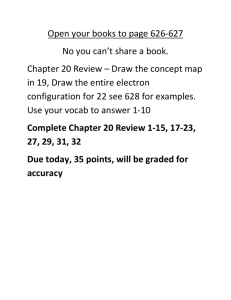Binding in Crystals (Kittel Ch. 3)
advertisement

Binding in Crystals (Kittel Ch. 3) A crystal is a repeated array of atoms Why do they form? What are characteristic bonding mechanisms? Do particular mechanisms lead to particular types of crystal structures? Binding of atoms to form crystals • Binding is due to the electrons Ultimate description is quantum mechanics Quantum states of electrons change as atoms are brought together • Leads to solid crystal structures of the nuclei • Can understand basic bonding mechanics from simple quantum arguments Full quantitative understanding now possible - more later in course Basic types of binding • Van der Waals • Ionic Closed-Shell Binding Ionic Binding • Metallic • Covalent • (Hydrogen) Covalent Binding Metallic Binding Van der Waals Bonding • Attraction because electrons can interact and be correlated even if they are on well-separated atoms • Consider closed shell “inert” that does not form strong chemical bonds • Isolated closed shell atom - electron distributed symmetrically around the atom • What happens if two atoms come together? + Van der Waals Bonding • What happens if two closed shell atoms come together? + + - - + - + • Electrons on one atom are attracted to the other nucleus, but repelled by the other electrons • Energy reduced - a net attraction - because the electrons can correlate to reduce the repulsion Van der Waals Bonding • Quantum Effect: Electron on each atom is like a fluctuating dipole - uncertainty principle + - + R • Dipole on atom 1 creates electric field E on atom 2 proportional to 1/R3 • E generates dipole D on atom 2: D = α E where α = polarizability • The interaction of the two dipoles is proportional to 1 DE~ 6 R • Always attractive Rare Gas Solids 1 • Attractive energy ~ R 6 • The analysis breaks down at short distance where the wavefunctions overlap Short distance repulsion - Due to exclusion principle • Final forms for interaction between two atoms A B E ( R ) ~ − 6 + 12 R R ⎛R A E( R ) ~ − 6 + B exp⎜ ⎜ρ R ⎝ (Lennard-Jones) ⎞ ⎟ ⎟ ⎠ A, B, ρ empirical parameters (exponential) Energies of Crystal Total Energy of Crystal The general shape applies for any type of binding Distance Between Atoms Equilibrium Lattice Constant • Ecrystal= N Ecell and Vcrystal = N Vcell • Ecell is given by all pairwise interactions of an “origin” atom 6 ⎡ ⎛ σ ⎞12 ⎛ σ ⎞ ⎤ ⎟⎟ − ∑ ⎜⎜ ⎟⎟ ⎥ E ( R ) = 2 Nε ⎢∑ ⎜⎜ ⎢⎣ i ⎝ ρ i R ⎠ i ⎝ ρi R ⎠ ⎥ ⎦ where R is the nearest neighbor distance, ρi is the distance to atom i in units of R, and 4εσ 6 ≡ A, 4εσ 12 ≡ B ⎡⎛ σ ⎞12 ⎛ 1 • Also E ( R ) = 2 Nε ⎢⎜ ⎟ ∑ ⎜⎜ ⎢⎣⎝ R ⎠ i ⎝ ρ i 12 ⎞ ⎛σ ⎞ ⎟⎟ − ⎜ ⎟ ⎝ R⎠ ⎠ 6 ⎛ 1 ∑i ⎜⎜ ρ ⎝ i dimensionless sums • Minimum is for dE/dR = 0 ⎞ ⎟⎟ ⎠ 6 ⎤ ⎥ ⎥⎦ Rare Gas Solids • Atoms nearly spherical • Short-range non-directional attraction and repulsion ⇒ Close packed structures HCP or FCC • For the fcc structure 12 ⎛1⎞ ∑i ⎜⎜ ρ ⎟⎟ = 12.13188 ⎝ i⎠ 6 ⎛1⎞ ∑i ⎜⎜ ρ ⎟⎟ = 14.45392 ⎝ i⎠ R0 dE (R = R0 ) = 0 ⇒ = 1.09 dR σ in very good agreement with the nearest-neighbor distance in Ne, Ar, Kr, Xe Ionic Solids • Much stronger binding than Van der Waals attractive energy ~ 1/R • 1. Pay energy to form ions Na Cl Na+ Cl - ionization energy of Na+ - electron affinity of ClNa+ • 2. Gain energy to bring ions together. cohesive energy- • Is there a net attraction? Cl - Na+ Cl - Na+ Cl - Na+ Cl - Na+ Cl - Na+ Cl - Ionic Solids • • • • • • Attractive (electrostatic) interaction ~ ± q R ij attraction for opposite charge, repulsion for same charge long range Result: Attractive energy defined to be - αq2/R, α is the Madelung constant (depends on structure) q= charge, R = nearest neigh. dist. in crystal 2 • Repulsion similar to closed shell systems (exponential works best) • Final form Ecell(R) = - αq2/R + zλ exp(-R/ρ) • (z = number of nearest neighbors, λ = parameter) Ionic Solids • Madelung constant α α = ∑ ± i 1 ρi • sum over each ion i , the sign depends on the charge of I • If reference ion negative, + will apply to positive ions • Care must be taken for the series to converge. • General Method: Ewald sum given in Kittel appendix • Convergent sums can be found by summing over neutral shells of neighbors Values of α NaCl structure CsCl struc. (bcc) ZnS structure 1.748 1.763 1.638 α = ∑± i 1 ρi • Ex. Calculate the Madelung constant of a 1D line of ions of alternating signs with ion spacing R. The reference ion is negative • Hint: ln (1+x) = x-x2/2+x3/3-x4/4 NaCl Structure Face Centered Cubic Bravais Lattice Favored for ionic crystals with large size difference Close packed negative ions with small positive ions CsCl Structure z y X a3 a2 a1 Simple Cubic Bravais Lattice From http://www.ilpi.com/inorganic/structures/cscl/index.html Favored for ionic crystals with small size difference Covalent crystals Covalent bond - usually formed from two electrons, one from each atom - the spins of the atoms are antiparallel - electrons partly localized in the region between the two atoms • The covalent bond has strong directional properties, so the crystals formed by covalent bonding tend to be less packed. • The strength of the covalent bond can be comparable to ionic bonds • There is a continuous range of crystals between the ionic and covalent limits. ZnS and Diamond structure • Favored if there is strong directional covalent bonding • Each atom has 4 neighbors in tetrahedron • Explained by simple bonding pictures and full electronic calculations ZnS Structure with Face Centered Cubic Bravais Lattice C, Si, Ge form diamond structure with only one type of atom (110) plane in diamond structure crystal z y X (110) plane in ZnS crystal zig-zag Zn-S chains of atoms (diamond if the two atoms are the same) Calculated valence electron density in a (110) plane in a Si crystal (Cover of Physics Today, 1970) Metallic binding A B C • Tends to be non-directional because electrons are spread out • The valence electrons of the atom are free to move • Typically leads to close packed structures • See Kittel Table 3 - almost all metals are FCC, HCP, or BCC Hydrogen Bonds • H is a special case • If it is ionized it is just a single proton (unlike all other atoms in the periodic table) • A proton can always be attracted to regions of high electron density - i.e., it can cause extra binding because it attracts electrons Example: Water -2 O -2 O Proton attracting second water molecule • (Does not happen with other atoms because of the repulsion of the core electrons) Atomic and Ionic Radii • Atoms and ions have typical sizes • Governed by cores which are filled shells and do not change much in different solids • Somewhat arbitrary, but chosen so that sum of radii is nearest neighbor distance • Tables in Kittel Na+ Cl - Summary: binding of crystals • Four primary types of binding: van der Waals, ionic, covalent, metallic • Typical structures: – Close packed for rare gases, metals – Simple two-atom-per-cell structures with large Madelung constants for ionic crystals – Open structures with few neighbors, directional bonds for covalent binding






